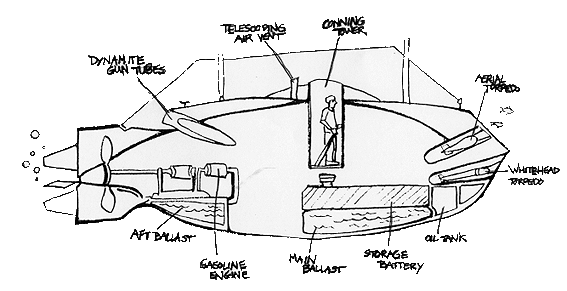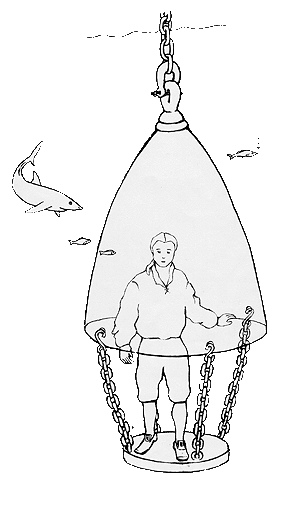Submarine Development
A Short History
Underwater exploration has fascinated people for thousands of years, yet submarine travel did not become common until the mid-twentieth century.
The ancient Athenians used divers in secret military operations, and a legend maintains that Alexander the Great descended into the sea in a primitive diving bell.
Many talented and curious people dabbled with submersible boat designs, but achieved limited success. It was not until 1900, when the U.S. Navy commissioned its first submarine.
This essay will discuss a few key developments in the history of American submarines.
The first American submarine was designed before the Revolutionary War by David Bushnell, a young inventor from Connecticut. He designed and built a one-man submersible vessel that he called Turtle. Bushnell's Turtle featured a hand-cranked screw-like oar that moved the boat forward and back underwater, air pipes that brought fresh air into the boat, ballast tanks that took on water to dive and emptied to ascend, and a primitive torpedo to attack enemy ships.
Encouraged by George Washington and Thomas Jefferson, Bushnell adapted his vessel to use against the British during the war. Turtle was sent to New York harbor in September 1776 to surprise the British ships blockading the city. Turtle's pilot Ezra Lee crept up on HMS Asia and attempted to attach explosives to the side of the wooden ship, but failed to do so before losing control of the boat. Lee escaped, but tried again to attack the British one month later without success. Despite Turtle's failures, Bushnell proved that a boat could be used for underwater surprise attacks.
Between the American Revolution and the Civil War many individuals experimented with submarine technology, including American Robert Fulton, an innovator and promoter of the steam engine. In 1800, Fulton completed his version of a submarine, Nautilus. Fulton's design introduced elements that may be found in modern submarines, such as adjustable diving planes for easy vertical maneuvering underwater, a dual system of propulsion, and a compressed air system that allowed the crew about four hours of underwater travel.
As naval surface ships continued to develop throughout the nineteenth century, submarines were still considered experimental and unsafe for the U.S. Navy. However, during the Civil War, both Union and Confederate forces experimented with submarines. One such experiment was H.L. Hunley named for its financier Horace L. Hunley. His boat sank twice in training missions killing 11 crew members, including Hunley himself. Despite these tragedies, Hunley was called to battle on February 17, 1864.

Powered by nine men working a hand-cranked propeller, Hunley set out underwater to attack U.S.S. Housatonic in Charleston Harbor.Hunley's crew used its spar torpedo to attack and sink Housatonic. Hunley became the first submarine ever to sink an enemy ship, however, Hunley never surfaced again, losing her entire crew. The submarine's potential as a surprise attack vessel finally was realized, but the problem of working safely underwater remained unresolved.
THE FIRST SUCCESSFUL AMERICAN SUBMARINE
Ten years after the end of the Civil War, Irish-born John Holland began designing and building submarines in the United States. Holland submitted his first submarine design to the U.S. Navy in 1875, which at the time was dismissed as impractical. Seeing this rejection as a challenge, Holland quickly went back to the drawing board to redesign and improve on the construction of these underwater boats.
By 1888, the U.S. Navy recognized the potential for submarines in its fleet and held a design competition for a new underwater vessel. Holland won the competition and began building the submarine Pluger five years later. After experiencing difficulties with Plunger, Holland began work on another submarine that he named Holland VI.
For his sixth submarine, Holland introduced a new method of propulsion using a gasoline engine. Holland designed a small, lightweight gasoline engine that turned a propeller while the boat cruised on the surface. The engine ran a generator, a machine that produces electricity, to charge batteries necessary to run an electric motor during underwater operations. Holland's efforts proved successful and he was able to persuade the Navy in April of 1900 to purchase this submarine. It was added to the fleet as USS Holland (SS-1)six months later.

IMPROVED PROPULSION
Although the gasoline engine worked well on paper, the engine had flaws. Gasoline is highly flammable and unstable. Using this fuel in a confined environment, such as the submarine, endangered the crew. Another danger were the batteries that ran the electric motor during underwater travel. They were heavy, bulky, terribly inefficient, and potentially explosive. Finding a safer means of propulsion was needed if the submarine was ever to submerge for long periods of time.
Around the same time Holland was creating his submarines, German scientist Rudolf Diesel developed an excellent substitute for the gasoline engine. Diesel's engine used a fuel that was more stable than gasoline and could be stored safely. The engine also did not need an electric spark to ignite the fuel, adding another element of safety. These advantages, plus improved fuel economy, granted submarines with Diesel engines longer and safer cruises on the surface. While underwater, batteries were still necessary to provide power. After 1909, Diesel engines would be used in American submarines for nearly 50 years.
THE NUCLEAR- POWERED SUBMARINE
Despite the success of diesel-powered submarines, the quest for a single power source continued. The concept of nuclear power was discovered by German scientists in the 1930's. Upon learning of this idea, American physicist Ross Gunn visualized the potential for nuclear-powered submarines and Phillip Abelson first sketched an image of one. The most recognized proponent of nuclear-powered submarines in the U.S. Navy was Admiral Hyman G. Rickover.
Rickover managed a research team that converted the concepts of nuclear power into working submarines. Nuclear power uses atoms, the smallest particles of an element, to produce an enormous amount of energy. That energy allows the power plants on submarines to super heat water and create steam. The steam then powers a giant turbine which turns the sub's propeller. Those small nuclear power plants on submarines could supply the necessary power for these boats to travel up to 500,000 miles and to stay underwater almost indefinitely without refueling.
Rickover convinced the Navy and the Atomic Energy Commission that nuclear power was the ideal propulsion method for submarines. On January 17, 1955, the first nuclear-powered submarine, USS Nautilus (SSN-571) went to sea. On her first voyage, Nautilus traveled completely submerged in the Atlantic for more than 1,300 miles. In 1958, she traveled under the polar ice cap and reached the North Pole.
Today's fleet of American nuclear submarines is able to spend up to six months on submerged patrol. Submarines have two complete crews. When a boat returns from a lengthy cruise, the crews rotate. Since the vessel is refueled only once or twice over its lifetime, there is no need to "stop for gas. " However, subs still need to stop to restock food and supplies.
THE FUTURE OF SUBMARINES
Changes in world politics and further adaptations of sea, land, and space technologies are creating new challenges for submarines in the 21st century. In the future, some submarines may contain no crew at all, but merely computer technology that talks to satellites and transfers information to distant military bases for analysis.
Submarines now are an essential part of the U.S. Navy, which would not have been possible without the ingenuity and vision of the innovators described in this essay.





